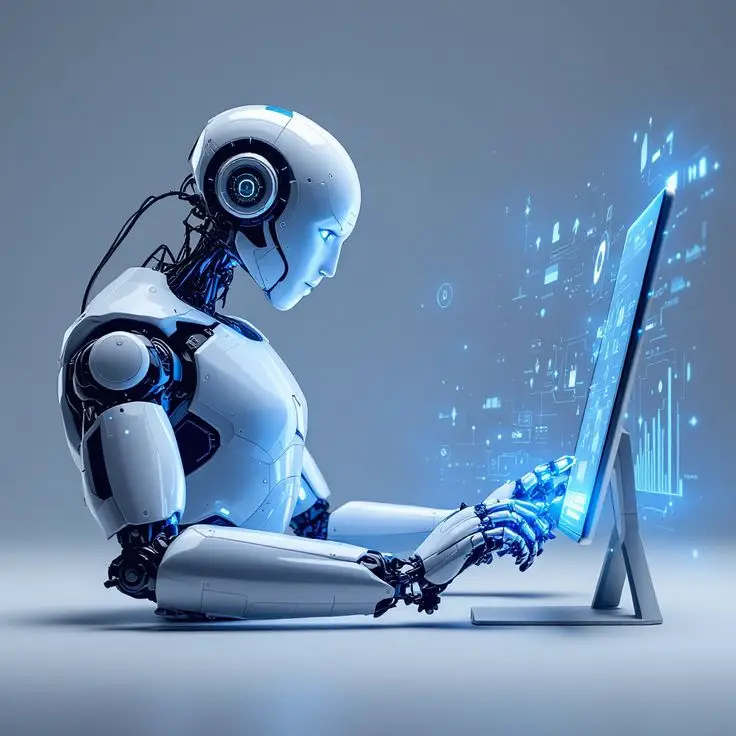Artificial Intelligence (AI) has evolved from being a futuristic concept into a force actively shaping industries, economies, and our daily lives. In 2025, AI is no longer just a support tool—it’s becoming the backbone of digital transformation. From personalized healthcare and AI-driven education to generative AI in creativity and ethical frameworks, this year marks a turning point where adoption meets accountability. In this article, we’ll explore the Artificial Intelligence trends in 2025, offering a clear roadmap of what you need to know to stay future-ready.

Why 2025 Is a Landmark Year for AI:
The last few years have set the stage for exponential AI growth. Cloud providers, startups, and governments have invested billions in AI research, policy, and infrastructure. But what makes 2025 special?
- Wider Adoption: AI is no longer limited to tech giants—small businesses and individuals are leveraging AI tools.
- AI Regulation & Ethics: Governments worldwide are enforcing responsible AI use, focusing on transparency and fairness.
- Mainstream Generative AI: Tools like ChatGPT, Gemini, and Claude are evolving beyond text generation, impacting video, music, and design.
- Shift to Human-AI Collaboration: Instead of replacing jobs, AI is increasingly assisting humans in decision-making, creativity, and productivity.
In short, 2025 represents the balance between innovation, regulation, and integration.
Generative AI is no longer a novelty—it’s an essential tool across industries. Businesses use it to create:
- Marketing content at scale.
- Hyper-personalized customer experiences.
- Product prototypes and designs within hours.
Companies like Adobe and Canva have integrated generative AI, enabling creators to transform ideas into professional output seamlessly. Meanwhile, enterprises are investing in custom AI models trained on their internal data.
How Industries Use Generative AI in 2025
| Industry | Application Example |
|---|---|
| Marketing | Automated ad copy, social media posts |
| Healthcare | Drug discovery, medical image generation |
| Entertainment | AI-generated movies, music, and art |
| Retail | Virtual try-ons, AI-driven product design |
2. AI in Healthcare: From Reactive to Preventive
- AI-powered diagnostics now detect diseases at early stages with higher accuracy than human specialists.
- Wearables integrated with AI monitor real-time health metrics and predict risks like heart attacks.
- Personalized treatment plans are created using AI-driven genomic data.
3. AI Regulation & Ethical AI
- The EU AI Act is in force, regulating how AI systems can be deployed.
- Governments in the U.S., India, and Japan are rolling out AI ethics frameworks to curb misuse.
- Transparency (AI explaining its decisions) and accountability (who takes responsibility) are top priorities.
4. AI-Powered Cybersecurity
- AI-driven detection systems can spot anomalies and prevent breaches in real-time.
- Adaptive security models continuously learn from new threats.
- Fraud detection AI protects financial transactions and e-commerce platforms.
5. The Rise of AI in Education
- Adaptive learning platforms tailor content to each student’s learning style.
- AI tutors provide instant guidance, feedback, and test preparation.
- Automated grading reduces teacher workload.
- Search engines now combine visual + text queries.
- AI tools can analyze videos for insights, detect emotions in audio, and generate interactive media.
- Applications like AI copilots in design, architecture, and research are revolutionizing workflows.
7. AI for Sustainability
- Smart grids use AI to optimize energy consumption.
- AI-powered agriculture predicts crop yield and optimizes water usage.
- Supply chain AI reduces waste and carbon emissions.
- In offices, AI copilots assist in coding, content creation, and analytics.
- In creative fields, artists collaborate with AI for music, art, and literature.
- In industries, workers use AI-powered tools to improve efficiency.
Challenges AI Faces in 2025
- Bias and Fairness: Ensuring AI outputs remain unbiased.
- Job Transition: Workers need reskilling to adapt to AI-enhanced roles.
- Data Privacy: Stricter regulations demand better data governance.
- Over-Reliance on AI: Decision-making without human oversight can be risky.
Looking Ahead: What This Means for You
- Stay Updated: Follow credible AI research and news outlets.
- Experiment with AI tools: Learn how they can enhance your productivity.
- Invest in Upskilling: Courses in data science, prompt engineering, and AI ethics are in demand.
- Think Responsibly: Adopt AI, but stay mindful of privacy and ethics.
The last few years have set the stage for exponential AI growth. Cloud providers, startups, and governments have invested billions in AI research, policy, and infrastructure. But what makes 2025 special?
- Wider Adoption: AI is no longer limited to tech giants—small businesses and individuals are leveraging AI tools.
- AI Regulation & Ethics: Governments worldwide are enforcing responsible AI use, focusing on transparency and fairness.
- Mainstream Generative AI: Tools like ChatGPT, Gemini, and Claude are evolving beyond text generation, impacting video, music, and design.
- Shift to Human-AI Collaboration: Instead of replacing jobs, AI is increasingly assisting humans in decision-making, creativity, and productivity.

